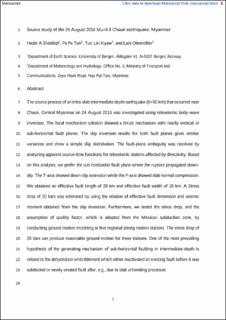Source Study of the 24 August 2016 Mw 6.8 Chauk, Myanmar, Earthquake
Journal article, Peer reviewed
Accepted version
Permanent lenke
https://hdl.handle.net/11250/2753244Utgivelsesdato
2018Metadata
Vis full innførselSamlinger
- Department of Earth Science [1103]
- Registrations from Cristin [10412]
Sammendrag
The source process of an intraslab intermediate‐depth earthquake (h=90 km) that occurred near Chauk, central Myanmar, on 24 August 2016 was investigated using teleseismic body‐wave inversion. The focal mechanism solution showed a thrust mechanism with nearly vertical or subhorizontal fault planes. The slip‐inversion results for both fault planes give similar variances and show a simple slip distribution. The fault‐plane ambiguity was resolved by analyzing apparent source time functions for teleseismic stations affected by directivity. Based on this analysis, we prefer the subhorizontal fault plane where the rupture propagated down‐dip. The T‐axis showed down‐dip extension while the P‐axis showed slab normal compression. We obtained an effective fault length of 20 km and effective fault width of 18 km. A stress drop of 20 bars was estimated using the relation of effective fault dimension and seismic moment obtained from the slip inversion. Furthermore, we tested the stress drop, and the assumption of quality factor, which is adopted from the Mexican subduction zone, by conducting ground‐motion modeling at five regional strong‐motion stations. The stress drop of 20 bars can produce reasonable ground motion for these stations. One of the most prevailing hypothesis of the generating mechanism of subhorizontal faulting in intermediate depth is related to the dehydration embrittlement, which either reactivated an existing fault before it was subducted or newly created fault after, for example, due to slab unbending processes.
